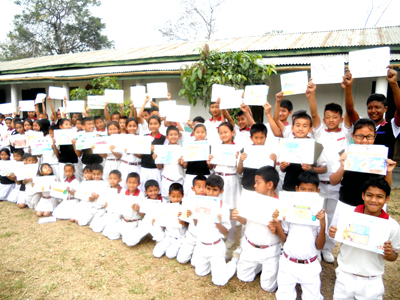Children do their bit

EMN
Dimapur, March 6
[dropcap]P[/dropcap]ollution, desertification, increasing, depleting ground water and weak environmental security continue to challenge policy makers and society alike. While strides have been made in technology to make men’s life easier, the environment continues to suffer even while various programs and activities continue to be undertaken by the society in general to protect and preserve the health of the environment.
Local institution Brighter Academy carried out an activity they dubbed the National Environment Awareness Campaign 2014-2015 in collaboration with the Nagaland Pollution Control Board.
The event was conducted with the “rainwater harvesting” as part of the national theme ‘combating desertification, land degradation and drought.’The program aimed at spreading awareness among the young and the students’ community about the environmental problems facing the society in the recent times, as well as to examine the measures to combat the challenges.
“Land is a vital resource for producing food, preserving biodiversity, facilitating the natural management of water systems and acting as a carbon store,” the Dimapur-based institution stated in a press release issued to the media this week.
“Land degradation reduces the productivity of land. Dry lands can leave the soil exposed and vulnerable to climatic hazards such as drought. Degradation of land resources is manifested in desertification.”
Based the activities that were based on the themes, a painting competition was organized as a part of the event. Jims N Zeme, Kaidinlungbou Pamai and Mary Momin bagged the first, second and third prize, in that order.
Chongsang Chang, Thonjinrai Pamai, Kalilungbou Newmai, Amar Munda, Nilato, Sahad Uddin, Wichamluliu Newmai and Keviletuo Metha won the consolation prizes, the academy stated.
The eco-club members led by teacher-in-charge Robi Nayak, also undertook other activities such as fitting bamboo gutters to collect rainwater for school toilets; recharging rainwater into the school well to improve ground water storage. Another highlight was a discourse delivered by school manager KK Newmai.
“In the recent years, the decrease in ground water table has been felt even in places like Dimapur for various reasons. To combat such shortfall, development of soak pits, conservation of local water bodies, water harvesting techniques like rainwater harvesting need to be developed,” the institution explained.
“Rainwater harvesting is a simple and economical way of preserving every drop of water that falls on the earth. It can be collected and recharged into the ground in underground tanks or even into the open wells rather than allowing it to run off.”
Desertification: Dangers Nagaland needs to understand
Desertification refers to the persistent degradation of dry land ecosystems by climatic variations and human activities. It occurs on all continents (except Antarctica) and affects the livelihoods of millions of people, including a large proportion of the poor in dry lands.
The U.N. Convention to Combat Desertification (UNCCD) defines it as “land degradation in arid, semiarid and dry sub humid areas resulting from various factors, including climatic variations and human activities.” Land degradation is in turn defined as the reduction or loss of the biological or economic productivity of dry lands.
In 2000, dry lands, which occupy 41% of Earth’s land area, were home to a third of the human population, or 2 billion people.
Ecosystem services are the benefits obtained by people from ecosystems, for instance crops, forage and wood. In dry lands, water scarcity limits the production of such services provided by ecosystems. Persistent, substantial reduction in the provision of ecosystem services as a result of water scarcity, intensive use of services, and climate change is a much greater threat in dry lands than in non-dry land systems. Areas most vulnerable to desertification are the sub-Saharan and Central Asian dry lands.
Desertification occurs as a result of a long-term failure to balance human demand for ecosystem services and the amount the ecosystem can supply. The pressure is increasing on dry land ecosystems for providing services such as food, forage, fuel, building materials, and water which is needed for humans, livestock, irrigation, and sanitation. This increase is attributed to a combination of human factors (such as population pressure and land use patterns) and climatic factors (such as droughts). While the global and regional interplay of these factors is complex, it is possible to understand it at the local scale.
Some 10 to 20% of dry lands are already degraded, and, if no countermeasures are taken, desertification will threaten future improvements in human well-being and possibly even reverse gains in some regions. Therefore, desertification is one of the greatest environmental challenges today and a major barrier to meeting basic human needs in dry lands.
How are desertification and human wellbeing linked?
“Desertification is potentially the most threatening ecosystem change impacting livelihoods of the poor. Persistent reduction of ecosystem services as a result of desertification links land degradation in dry lands to loss of human well-being.”
In dry lands, more people depend on ecosystem services for their basic needs than in any other ecosystem. Indeed, many of their resources, such as crops, livestock, fuelwood, and construction materials, depend on the growth of plants, which in turn depends on water availability and climate conditions.
Fluctuations in the services supplied by ecosystems are normal, especially in dry lands, where water supply is irregular and scarce. However, when a dry land ecosystem is no longer capable to recover from previous pressures, a downward spiral of desertification may follow, though it is not inevitable. More…
Desertification affects a wide range of services provided by ecosystems to humans: products such as food and water, natural processes such as climate regulation, but also non-material services such as recreation, and supporting services such as soil conservation. Changes can be quantified and methods are available to prevent, reduce, or reverse them.
When faced with desertification, people often respond by making use of land that is even less productive, transforming pieces of rangeland into cultivated land, or moving towards cities or even to other countries. This can lead to unsustainable agricultural practices, further land degradation, exacerbated urban sprawl, and socio-political problems. (Source: greenfacts.org)

